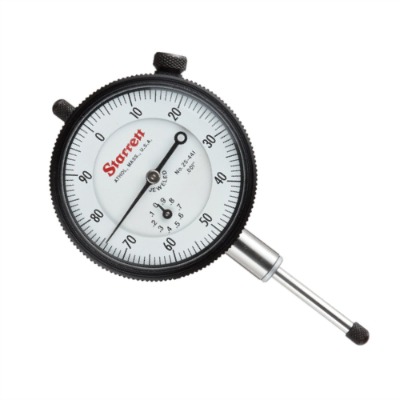How to select a dial indicator was discussed in last month’s column. Now that you own it, here are a number of tips to keep it working smoothly and accurately.
First, mount your dial indicator correctly. The ideal method is to mount it from the back, using one of the optionally available lug or rack- type backs available from most suppliers. Mounting by the case or the stem is less desirable, because these components are part of the mechanism. Do not allow a setscrew to bear directly on the stem–the stem will deform, interfering with the movement of the spindle in its bearings. If the indicator must be mounted by the stem, it is essential to use a split bushing or a collet to distribute the clamping force evenly. It should go without saying that the indicator must be mounted securely to the fixture, with no wobble or play.
Worn or loose contacts can also cause false readings, so it is essential to inspect them frequently for wear and tightness. The contact should be screwed onto the spindle “fingertip tight”–just tight enough so it does not loosen up during use. Do not use pliers or a wrench–too much torque will distort the spindle, causing the mechanism to bind.
Replace contacts as soon as wear is detectable. If wear is rapid, consider changing to a harder material.
Hardened steel contacts wear quickly when used against rough or abrasive surfaces and may also be affected by corrosive agents in the work environment. Chromium steel contacts offer better corrosion resistance, but are only marginally tougher than hardened steel. Tungsten carbide or diamond contacts are often the most cost-effective, even though they are the most expensive. They resist wear much longer, thus reducing the need for replacement parts and labor. More importantly, less wear means the indicator will produce fewer false readings.
If the indicator has been sitting idle for a while, the spindle may stick. Do not oil it. Work it in and out a few times by hand: chances are it will free up. Oil acts like a magnet for dust. Every time the spindle retracts into the
case, it will pull contaminants into the indicator’s precision movement. The oil, itself, will also harden with time, causing even more sticking. Too often, the problem of sticky oil is improperly treated by adding more oil, until the movement gets loaded with a gummy mess.
The only part of an indicator that should ever be lubricated is the jeweled movement. Manufacturers typically use the point of a pin to apply a minuscule amount of watch-grade oil at this location ( a drop of oil from a can would be about 20 times too much). Only individuals trained in the proper methods should open up the case to oil the jeweled movement. Dial indicators that have been cared for properly will rarely require this.
Use a soft, lint-free cloth to remove dirt and oil from the spindle. Clean the crystal with soapy water, benzene, or a soft eraser. Replace scratched crystals and illegible faces. If the indicator looks like it is in poor shape, chances are it will be abused even more. If you keep it clean, it will be treated like the precision instrument it is. And that will mean years– perhaps decades–of accurate measurements and trouble-free use.

